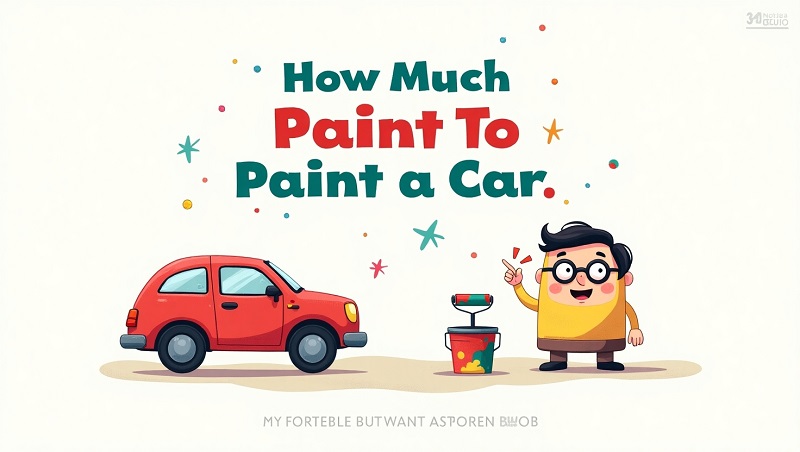When it comes to giving your car a brand-new look or restoring it after years of wear and tear, one of the most important steps is painting. However, before diving into the process, one of the most commonly asked questions by DIY enthusiasts, car owners, and even professional restorers is: “How much paint do I need to paint a car?”
This question doesn’t have a one-size-fits-all answer. The exact amount of paint you need depends on several factors, including the size of the vehicle, the type of paint used, the number of coats, and the technique you apply. This detailed guide will break down every aspect of car painting, helping you understand the cost, materials, quantity, and techniques to determine exactly how much paint is required for your car project.

Understanding the Basics of Automotive Paint
Before estimating the amount of paint required, it’s crucial to understand the components involved in automotive painting. Paint for cars typically involves a multi-layer process which includes the primer, basecoat (color), and clear coat. Each of these layers contributes to the final appearance and durability of the car’s surface.
1. Primer: The first coat that prepares the car’s surface by filling imperfections and providing adhesion for the paint.
2. Basecoat: This is the actual color layer that gives your car the visual appeal.
3. Clear Coat: A transparent, glossy layer that protects the paint from UV rays, oxidation, and minor scratches.
Every one of these layers requires a specific amount of paint, and skipping or underapplying any layer can lead to poor results.
Factors That Influence the Amount of Paint Needed
To accurately calculate how much paint you’ll need to paint a car, consider the following factors. These elements will affect not only the quantity of paint but also how efficiently it covers the surface.
1. Size of the Vehicle
The most obvious factor is the size and type of the vehicle you’re painting. A small car like a Honda Civic or a Fiat 500 will require significantly less paint than a full-sized SUV or a Ford F-250 truck. The surface area you intend to paint directly affects the total paint volume needed.
| Vehicle Type | Estimated Surface Area (sq. ft.) |
|---|---|
| Small Car (e.g., hatchback) | 100 – 120 sq. ft. |
| Sedan | 120 – 150 sq. ft. |
| SUV | 150 – 200 sq. ft. |
| Truck | 200 – 250+ sq. ft. |
2. Type of Paint Used
Automotive paints come in various types—single-stage paints and two-stage systems being the most common. Single-stage paint combines color and gloss in one, while a two-stage system separates the color (basecoat) and clear coat. A two-stage system typically requires more paint since you’re applying both base and clear layers separately.
3. Number of Coats Applied
The number of coats you apply plays a big role in the amount of paint needed. A professional paint job generally includes:
- 1–2 coats of primer
- 2–3 coats of basecoat
- 2–3 coats of clear coat
Each layer adds up to the total paint usage, especially when aiming for depth and uniform coverage.
4. Color of the Paint
Believe it or not, the color of the paint can also impact how much is required. Lighter colors often require more coats to fully cover a darker base, especially if you’re switching from a dark color like black to a light shade like white or silver. Pearlescent and metallic colors may also need more coats for an even finish.
5. Method of Application
Whether you’re using a spray gun or aerosol cans will affect how efficiently the paint is used. Spray guns, particularly HVLP (High Volume Low Pressure) guns, offer better coverage with minimal overspray. On the other hand, aerosol cans waste more paint, and you’ll need more to achieve the same coverage.
How Much Paint Do You Need Per Car Size?
Let’s now break it down into actual paint volumes based on typical vehicle categories.
For Small Cars (e.g., Toyota Yaris, Mini Cooper)
- Primer: 1 – 1.5 quarts
- Basecoat: 2 – 2.5 quarts
- Clear Coat: 2 – 2.5 quarts
- Total Paint Needed: Around 1 gallon of each (to be safe)
A small car can often be painted with 3 quarts of basecoat, especially if it’s a single-stage job. If you’re painting the entire car, including door jambs and interior panels, you might require slightly more.
For Sedans (e.g., Honda Accord, Toyota Camry)
- Primer: 1.5 – 2 quarts
- Basecoat: 3 – 4 quarts
- Clear Coat: 3 – 4 quarts
- Total Paint Needed: About 1.5 gallons of each
A medium-sized sedan will require about 1.5 gallons of base and clear coat if multiple coats are applied properly. This includes moderate overspray allowance.
For SUVs (e.g., Ford Explorer, Jeep Grand Cherokee)
- Primer: 2 – 2.5 quarts
- Basecoat: 4 – 5 quarts
- Clear Coat: 4 – 5 quarts
- Total Paint Needed: About 2 gallons of each
Larger vehicles require more surface coverage, especially for areas like the roof, tailgate, and bumpers.
For Trucks (e.g., Ford F-150, Ram 1500)
- Primer: 2.5 – 3 quarts
- Basecoat: 5 – 6 quarts
- Clear Coat: 5 – 6 quarts
- Total Paint Needed: Up to 2.5 gallons of each
Pickup trucks have larger bodies and flat panels which need a significant amount of paint, especially when covering the bed, roof, and larger side panels.
Additional Supplies Required for Painting a Car
Besides the actual paint, you’ll need several other materials to ensure a smooth and professional-looking finish:
- Sandpaper (various grits from 320 to 1500+)
- Masking Tape and Paper/Plastic
- Body Filler (if needed)
- Paint Thinner/Reducer
- Mixing Cups and Stir Sticks
- Spray Gun or HVLP System
- Respirator Mask and Protective Gear
- Paint Booth or Clean, Dust-Free Area
Each of these materials adds to the cost and quality of the paint job and should not be ignored, especially if you want your paint to last.
Step-by-Step Process for Painting a Car
1. Prep Work
Preparation is arguably the most important step in painting a car. This includes sanding down the existing paint, fixing dents or rust, cleaning the surface, and applying masking tape.
2. Primer Application
Apply 1–2 coats of primer evenly across the entire surface. Let each coat dry before applying the next, and sand lightly if needed.
3. Basecoat Application
Spray 2–3 light coats of the color basecoat. Allow each layer to flash off (dry partially) before adding the next coat.
4. Clear Coat Application
Apply 2–3 coats of clear coat to seal in the color and add a glossy, protective finish.
5. Curing and Polishing
Let the paint cure for at least 24–48 hours. After curing, wet sand and polish the surface for a smooth and professional finish.
DIY vs. Professional Paint Jobs: Paint Usage Compared
A professional body shop usually has optimized equipment and experience to minimize paint waste and maximize finish quality. DIY projects often use more paint due to inefficiencies in application and mistakes like overspray or uneven coverage.
A professional shop might use around 1–1.5 gallons total, while a DIYer might use closer to 2 gallons for the same car due to rework or uneven spraying.
Tips to Reduce Paint Waste and Improve Finish
- Use a high-quality HVLP spray gun to control overspray and maximize paint usage.
- Practice on a test panel before applying to the car.
- Ensure proper mixing ratios of paint and reducer as specified by the manufacturer.
- Avoid painting in humid or dusty conditions to reduce defects that may require rework.
- Use a consistent spray pattern and maintain proper distance from the surface.
Estimated Cost of Automotive Paint per Gallon
Here’s a rough price guide depending on the type of paint:
| Paint Type | Cost per Gallon |
|---|---|
| Primer | $30 – $70 |
| Basecoat (standard) | $50 – $150 |
| Basecoat (metallic/pearlescent) | $150 – $300 |
| Clear Coat | $50 – $100 |
So, for a complete project, paint costs alone can range from $150 to $700 depending on the vehicle and paint quality.
Conclusion: Plan Before You Paint
Painting a car is both a technical and artistic process. Whether you’re doing it yourself or hiring a professional, understanding how much paint is needed to paint a car is essential to avoid overspending or under-preparing. Consider your car’s size, the type of paint, and your desired finish. For most standard sedans, expect to use about 1.5 gallons each of basecoat and clear coat, with smaller or larger vehicles needing proportionally less or more.
Investing in the right amount of paint, preparing it correctly, and applying it professionally ensures that your vehicle not only looks fantastic but stays protected for years to come.
FAQs
Q1: Can I paint a car with just one gallon of paint?
Yes, for smaller cars and single-stage paint jobs, one gallon may be enough. However, for best coverage and multiple coats, more is usually needed.
Q2: How many coats of paint are ideal for a car?
Typically, 2–3 coats of basecoat and 2–3 coats of clear coat are recommended for a professional-looking result.
Q3: Is it cheaper to paint your car yourself?
DIY painting is cheaper upfront but requires equipment and has a steeper learning curve. Mistakes can lead to costly rework.
Q4: What’s the difference between single-stage and two-stage paint?
Single-stage paint combines color and clear in one. Two-stage paint applies a separate color and clear coat, offering better durability and depth.
Q5: How long does car paint last?
High-quality paint jobs can last 7–10 years if properly applied and maintained.


